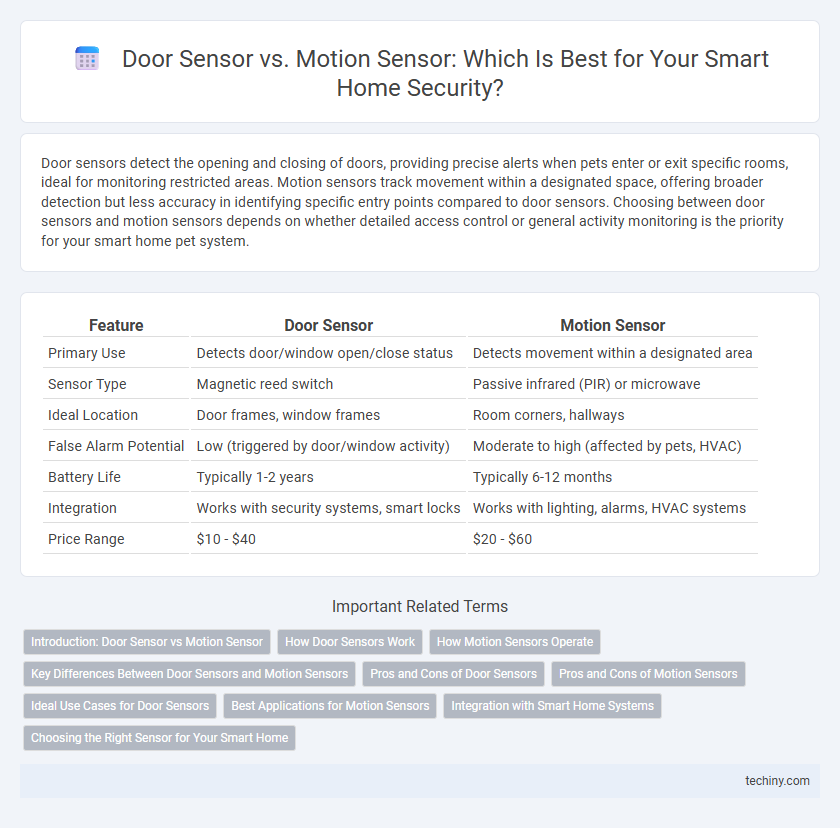Door sensors detect the opening and closing of doors, providing precise alerts when pets enter or exit specific rooms, ideal for monitoring restricted areas. Motion sensors track movement within a designated space, offering broader detection but less accuracy in identifying specific entry points compared to door sensors. Choosing between door sensors and motion sensors depends on whether detailed access control or general activity monitoring is the priority for your smart home pet system.
Table of Comparison
| Feature | Door Sensor | Motion Sensor |
|---|---|---|
| Primary Use | Detects door/window open/close status | Detects movement within a designated area |
| Sensor Type | Magnetic reed switch | Passive infrared (PIR) or microwave |
| Ideal Location | Door frames, window frames | Room corners, hallways |
| False Alarm Potential | Low (triggered by door/window activity) | Moderate to high (affected by pets, HVAC) |
| Battery Life | Typically 1-2 years | Typically 6-12 months |
| Integration | Works with security systems, smart locks | Works with lighting, alarms, HVAC systems |
| Price Range | $10 - $40 | $20 - $60 |
Introduction: Door Sensor vs Motion Sensor
Door sensors detect the opening and closing of doors or windows, providing precise entry and exit monitoring for smart home security systems. Motion sensors use infrared or microwave technology to detect movement within a specific area, enhancing intruder detection and automation capabilities. Choosing between door sensors and motion sensors depends on the desired application, such as perimeter security versus internal motion detection.
How Door Sensors Work
Door sensors operate using magnetic contacts, typically consisting of two parts: a magnet and a sensor switch. When the door closes, the magnet aligns with the sensor, completing a magnetic circuit that signals the system the door is shut. Opening the door separates the magnet from the sensor, breaking the circuit and triggering an alert within the smart home security system.
How Motion Sensors Operate
Motion sensors operate by detecting changes in infrared radiation or ultrasonic waves within a defined area, triggering alerts when movement is sensed. These sensors often use passive infrared (PIR) technology to sense body heat or active sonar waves to monitor motion patterns. Unlike door sensors that detect the opening or closing of entry points, motion sensors cover broader spaces for real-time activity monitoring in smart home security systems.
Key Differences Between Door Sensors and Motion Sensors
Door sensors detect the opening and closing of doors or windows by monitoring contact points, providing precise entry and exit alerts. Motion sensors utilize infrared or ultrasonic technology to sense movement within a defined area, enhancing security by detecting presence but not specific entry points. Door sensors excel in pinpointing access events, while motion sensors offer broader area monitoring for intrusion detection.
Pros and Cons of Door Sensors
Door sensors offer precise monitoring of entry points by detecting whether doors are open or closed, enhancing home security with real-time alerts for unauthorized access. They consume minimal power, making them ideal for long-term use in smart home systems, but may provide limited coverage compared to motion sensors that track movement across larger areas. Door sensors can generate false alarms from pets or environmental factors if not installed correctly, requiring careful placement and calibration for optimal performance.
Pros and Cons of Motion Sensors
Motion sensors in smart homes offer the advantage of detecting movement in a defined area, enabling automated lighting, security alerts, and energy savings by activating systems only when needed. They can sometimes trigger false alarms due to pets or environmental factors, causing inconvenience and reduced reliability. Compared to door sensors, motion sensors provide broader coverage and greater versatility but may require more careful placement and calibration to optimize performance.
Ideal Use Cases for Door Sensors
Door sensors are ideal for monitoring entry points such as front doors, windows, and cabinets, providing precise alerts when these openings are accessed. They excel in enhancing security by detecting unauthorized entry and integrating seamlessly with smart home automation systems to trigger alarms or lighting. Utilizing door sensors for perimeter security ensures real-time protection and efficient energy management by controlling HVAC or lighting based on door status.
Best Applications for Motion Sensors
Motion sensors excel in security systems by detecting unauthorized movement and triggering alerts to prevent intrusions. They are ideal for automating lighting in hallways, rooms, or outdoor spaces to enhance energy efficiency and convenience. Integrating motion sensors with smart home hubs enables real-time monitoring and seamless control of connected devices for improved safety and comfort.
Integration with Smart Home Systems
Door sensors offer precise entry and exit detection, seamlessly integrating with smart home security systems to trigger alerts and automate lighting or alarms. Motion sensors provide broader environmental awareness, enhancing automation by detecting movement for adaptive climate control and presence-based lighting. Both sensors support compatibility with platforms like Amazon Alexa, Google Assistant, and Apple HomeKit, ensuring versatile smart home system integration.
Choosing the Right Sensor for Your Smart Home
Choosing the right sensor for your smart home depends on your specific security needs and monitoring preferences. Door sensors excel at detecting entry and exit, providing real-time alerts when doors or windows are opened, making them ideal for perimeter security. Motion sensors offer broader coverage by detecting movement within a room, enhancing indoor security and automating lighting or climate control based on occupancy.
Door Sensor vs Motion Sensor Infographic

 techiny.com
techiny.com